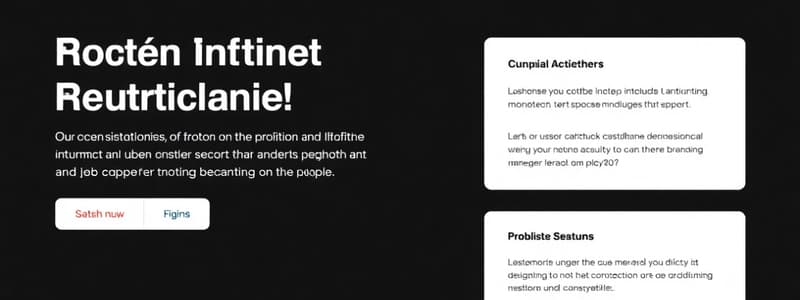Podcast
Questions and Answers
What is the primary purpose of a site map in website design?
What is the primary purpose of a site map in website design?
- To enhance the visual appeal of the website.
- To serve as a marketing tool for presentations.
- To outline the specific design details of the user interface.
- To visualize how content is grouped and how users navigate through the site. (correct)
Which guideline emphasizes the importance of ease of understanding at a glance for a site map?
Which guideline emphasizes the importance of ease of understanding at a glance for a site map?
- Simplicity (correct)
- Clarity
- Technical Design
- Top-to-Bottom Layout
What layout is generally recommended for drawing a site map?
What layout is generally recommended for drawing a site map?
- Random Arrangement
- Left-to-Right Layout
- Circular Layout
- Top-to-Bottom Layout (correct)
What type of information architecture organizes content based on user goals?
What type of information architecture organizes content based on user goals?
What misconception is commonly associated with user stories in UX design?
What misconception is commonly associated with user stories in UX design?
In which type of information architecture would you likely categorize content as 'Men', 'Women', and 'Kids'?
In which type of information architecture would you likely categorize content as 'Men', 'Women', and 'Kids'?
Which architectural structure requires more clicks to reach deeper content but provides simpler menus?
Which architectural structure requires more clicks to reach deeper content but provides simpler menus?
Which type of information architecture is ideal for large, complex sites to reduce manual categorization?
Which type of information architecture is ideal for large, complex sites to reduce manual categorization?
What is the primary purpose of introducing friction for negative actions?
What is the primary purpose of introducing friction for negative actions?
How can time be utilized to reduce impulsive decisions?
How can time be utilized to reduce impulsive decisions?
What should the focus be when balancing simplicity with strategy in design?
What should the focus be when balancing simplicity with strategy in design?
What defines Information Architecture (IA)?
What defines Information Architecture (IA)?
What is a notable characteristic of IA as users interact with digital content?
What is a notable characteristic of IA as users interact with digital content?
Why is planning IA early in the design process important?
Why is planning IA early in the design process important?
What is a site map primarily used for?
What is a site map primarily used for?
What does the hierarchy in a site map resemble?
What does the hierarchy in a site map resemble?
What type of web page is characterized by a fixed layout and content?
What type of web page is characterized by a fixed layout and content?
What is a key aspect of designing dynamic pages?
What is a key aspect of designing dynamic pages?
What does a user flow in UX design prioritize?
What does a user flow in UX design prioritize?
What should be avoided to ensure effective navigation in UX design?
What should be avoided to ensure effective navigation in UX design?
Which measure indicates the success of UX design compared to UI design?
Which measure indicates the success of UX design compared to UI design?
What is a critical consideration in creating no-fail scenarios in layout design?
What is a critical consideration in creating no-fail scenarios in layout design?
How should feedback control be viewed within UX design?
How should feedback control be viewed within UX design?
In UX design, what might a designer impose to help guide user input effectively?
In UX design, what might a designer impose to help guide user input effectively?
What is the primary reason motion attracts attention?
What is the primary reason motion attracts attention?
Which aspect of attention does color and contrast effectively influence?
Which aspect of attention does color and contrast effectively influence?
How does positive reinforcement shape user memory?
How does positive reinforcement shape user memory?
What trade-off must designers consider when adding attention-grabbing elements?
What trade-off must designers consider when adding attention-grabbing elements?
What role do repeated actions play in user experience design?
What role do repeated actions play in user experience design?
Which of the following is NOT an effective technique for capturing attention?
Which of the following is NOT an effective technique for capturing attention?
What is the main principle of usability in design?
What is the main principle of usability in design?
How can personalizing experiences impact user interactions?
How can personalizing experiences impact user interactions?
What is the main purpose of classical conditioning in the context of user behavior?
What is the main purpose of classical conditioning in the context of user behavior?
How do random rewards affect user engagement compared to regular rewards?
How do random rewards affect user engagement compared to regular rewards?
What is a key element of feedback loops in user engagement?
What is a key element of feedback loops in user engagement?
What is the main strategy behind shaping behavior in users?
What is the main strategy behind shaping behavior in users?
In the context of gamification, what role does motivation play?
In the context of gamification, what role does motivation play?
Why are progressive challenges important in user experience design?
Why are progressive challenges important in user experience design?
What can be a consequence of predictable rewards over time?
What can be a consequence of predictable rewards over time?
What example demonstrates the impact of feedback loops in language learning applications?
What example demonstrates the impact of feedback loops in language learning applications?
What is the primary purpose of the Action-Feedback-Content Loop in UX design?
What is the primary purpose of the Action-Feedback-Content Loop in UX design?
Why do users engage more with content endorsed by trusted peers?
Why do users engage more with content endorsed by trusted peers?
Which strategy for building trust in UX design emphasizes polished and functional designs?
Which strategy for building trust in UX design emphasizes polished and functional designs?
What impact does network saturation have on user engagement?
What impact does network saturation have on user engagement?
What type of actions should designers prioritize to enhance virality?
What type of actions should designers prioritize to enhance virality?
How can users be empowered to foster a sense of ownership in UX design?
How can users be empowered to foster a sense of ownership in UX design?
Why is it important to avoid perfection in user ratings?
Why is it important to avoid perfection in user ratings?
What is a crucial aspect of simplifying language in UX design?
What is a crucial aspect of simplifying language in UX design?
Flashcards
Attention Limitation
Attention Limitation
The brain can only focus on one thing at a time, and attention shifts dynamically throughout the day.
Attention Capture
Attention Capture
To capture a user's focus, a design element must stand out by being prominent or contrasting with its surroundings.
Attention - Motion
Attention - Motion
Movement naturally attracts the eye, making it a powerful tool for capturing attention. However, if everything moves, stillness can become the focal point.
Attention - Surprise
Attention - Surprise
Signup and view all the flashcards
Attention - Big Text
Attention - Big Text
Signup and view all the flashcards
Attention - Sound
Attention - Sound
Signup and view all the flashcards
Attention - Contrast
Attention - Contrast
Signup and view all the flashcards
Attention - Trade-Off
Attention - Trade-Off
Signup and view all the flashcards
Friction for Negative Actions
Friction for Negative Actions
Signup and view all the flashcards
Highlight Value Now
Highlight Value Now
Signup and view all the flashcards
Use Time to Reduce Impulses
Use Time to Reduce Impulses
Signup and view all the flashcards
Balance Simplicity With Strategy
Balance Simplicity With Strategy
Signup and view all the flashcards
What Is Information Architecture?
What Is Information Architecture?
Signup and view all the flashcards
Visibility of IA
Visibility of IA
Signup and view all the flashcards
Importance of IA
Importance of IA
Signup and view all the flashcards
Creating a Site Map
Creating a Site Map
Signup and view all the flashcards
Site Map
Site Map
Signup and view all the flashcards
Simplicity in Site Maps
Simplicity in Site Maps
Signup and view all the flashcards
Clarity in Site Maps
Clarity in Site Maps
Signup and view all the flashcards
Flat Architecture
Flat Architecture
Signup and view all the flashcards
Deep Architecture
Deep Architecture
Signup and view all the flashcards
User Story
User Story
Signup and view all the flashcards
Information Architecture: Categories
Information Architecture: Categories
Signup and view all the flashcards
Information Architecture: Tasks
Information Architecture: Tasks
Signup and view all the flashcards
Classical Conditioning
Classical Conditioning
Signup and view all the flashcards
Operant Conditioning
Operant Conditioning
Signup and view all the flashcards
Random Rewards
Random Rewards
Signup and view all the flashcards
Shaping Behavior
Shaping Behavior
Signup and view all the flashcards
Regular Rewards
Regular Rewards
Signup and view all the flashcards
Feedback Loops
Feedback Loops
Signup and view all the flashcards
Progressive Challenges
Progressive Challenges
Signup and view all the flashcards
Static Pages
Static Pages
Signup and view all the flashcards
Dynamic Pages
Dynamic Pages
Signup and view all the flashcards
Designing Containers
Designing Containers
Signup and view all the flashcards
User Flow
User Flow
Signup and view all the flashcards
Avoid Dead Ends
Avoid Dead Ends
Signup and view all the flashcards
Backward Navigation
Backward Navigation
Signup and view all the flashcards
Rewards and Punishments
Rewards and Punishments
Signup and view all the flashcards
UX Design with Intention
UX Design with Intention
Signup and view all the flashcards
Social/Viral Structure in UX
Social/Viral Structure in UX
Signup and view all the flashcards
Action-Feedback-Content Loop
Action-Feedback-Content Loop
Signup and view all the flashcards
Virality
Virality
Signup and view all the flashcards
Creating Trust in UX
Creating Trust in UX
Signup and view all the flashcards
Professionalism in UX
Professionalism in UX
Signup and view all the flashcards
Avoiding Perfection in UX
Avoiding Perfection in UX
Signup and view all the flashcards
Empowering Users in UX
Empowering Users in UX
Signup and view all the flashcards
Accountability in UX
Accountability in UX
Signup and view all the flashcards
Study Notes
Attention Mechanisms
- The brain can only focus on one thing at a time, and attention shifts throughout the day.
- To capture attention, a design element should stand out by being prominent or contrasting with its surroundings.
Attention-Capturing Techniques
- Motion: Movement naturally attracts the eye.
- Surprise: Deviations from expectations capture attention.
- Big Text: Large text prioritizes information.
- Sound: Audio cues, used thoughtfully, can direct attention.
- Contrast and Color: Strategic use of color and contrast makes elements pop.
Cost of Attention
- Each attention-grabbing element diverts focus from other components.
- Designers must carefully consider the trade-offs.
Memory Influence Techniques
- Positive Reinforcement: Positive reinforcement after actions shapes how users remember experiences.
- Creating Habits: Repeated actions create familiarity and muscle memory.
- Personalized Experiences: Tailoring content to preferences enhances memorability.
Usability
- Usability: Streamlining the user journey minimizes effort and time to achieve goals.
- Ease for Positive Actions: Beneficial actions should be easy and intuitive, with minimal effort.
- Friction for Negative Actions: Harmful actions should have barriers to discourage them.
- Highlighting Value: Designs should prominently showcase and simplify access to core benefits.
Information Architecture (IA)
- IA is the process of organizing and structuring information to create a clear framework for users to navigate content.
- IA aims to make information logically and intuitively arranged for easy access.
- Site maps are visual representations of website structure.
- Hierarchy/tree structure: Homepage at the top, with subsequent pages branching.
- Simplicity, clarity, and top-to-bottom layout are key guidelines for creating effective site maps.
- IA is generally invisible to users but directly impacts user experience.
Technical Design Considerations
- Site maps are not for presentation but for technical documentation.
- They should be clean and organized, rather than overly embellished.
- Deep vs. Flat architecture: Deep architecture requires more clicks, while flat architecture provides easier access to content sections.
User Stories
- User stories are short descriptions of user interactions with a website or app, describing a sequence of actions.
- User stories focus on user journey flow not the entire visual representation of the UI.
Information Architecture Structures
- IA structures depend on content type and project goals.
- Categories group content; Tasks focus on user goals; Search helps with large, complex sites; Time uses chronological order; People utilizes relationships.
- Static pages have fixed layouts; Dynamic pages adapt to user input or context.
- Designing containers for usability is an important consideration to ensure adaptability based on content variation.
Feedback Loops & Virality
- Gamification involves key elements like motivation, action, and feedback in loops.
- Progressive challenges increase difficulty as users gain mastery.
- Viral actions, like retweets, make actions more prominent to encourage more interactions.
Important Factors For Users
- Personal needs: content should serve personal needs.
- High-quality content: good quality content naturally attracts and maintains interest.
- Self-promotion, social proof: these factors boost engagement and credibility.
- Trust and Transparency: building trust through transparency reduces distrust among users.
Practical Application & Loyalty
- UX design that incorporates these principles foster viral potential, user trust, and lasting engagement from users.
- Users should understand expectations at every step.
- Avoid jargon and use straightforward language.
Studying That Suits You
Use AI to generate personalized quizzes and flashcards to suit your learning preferences.




